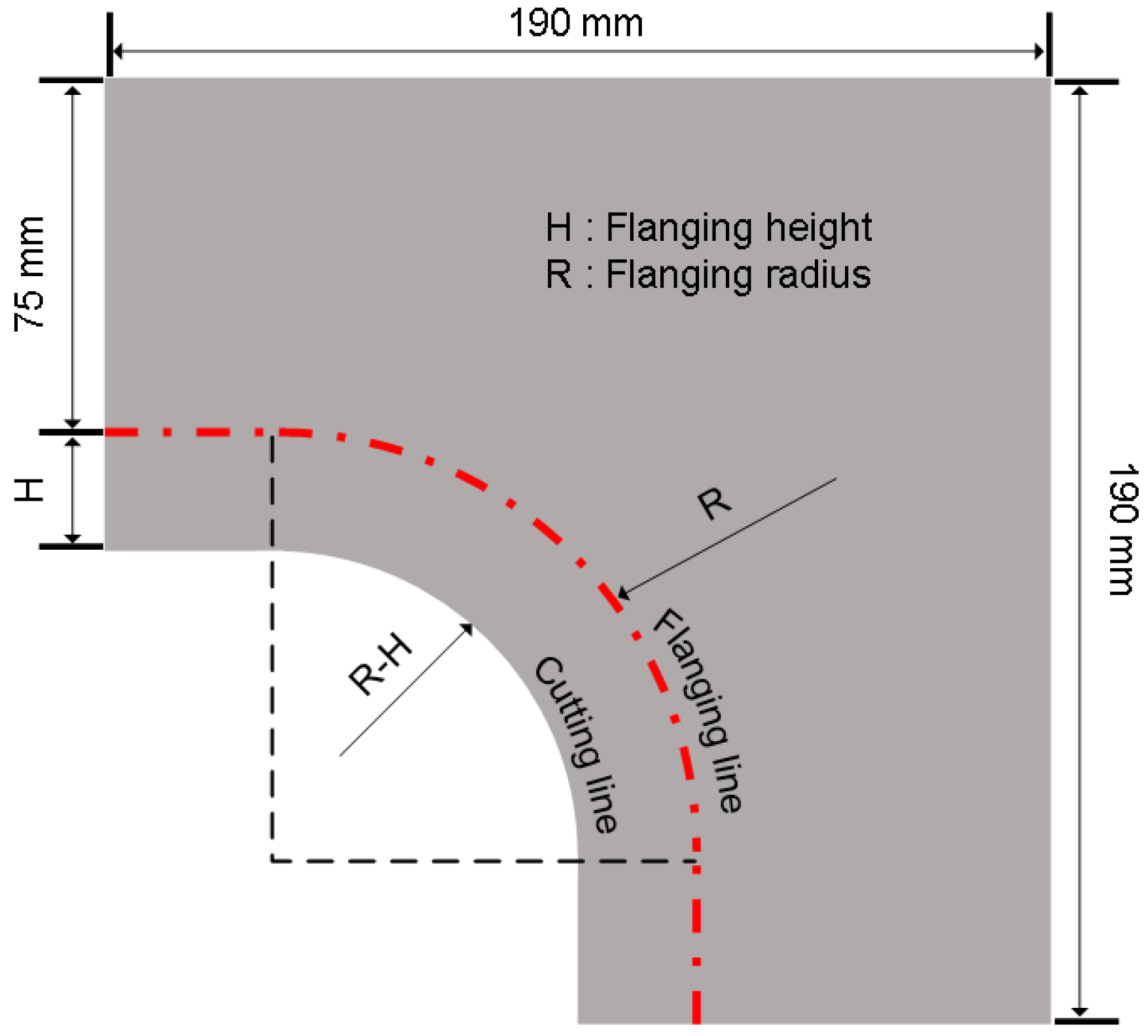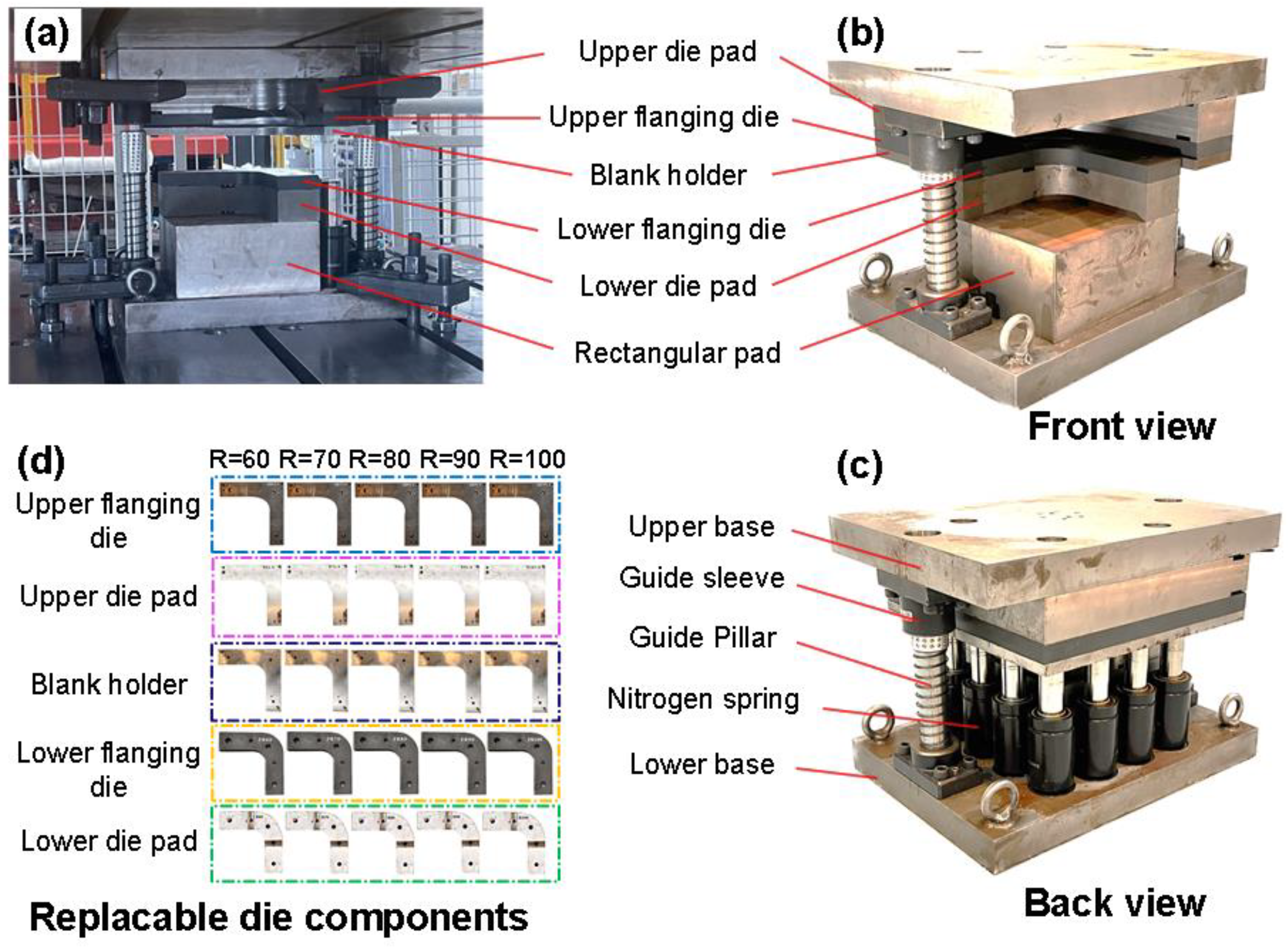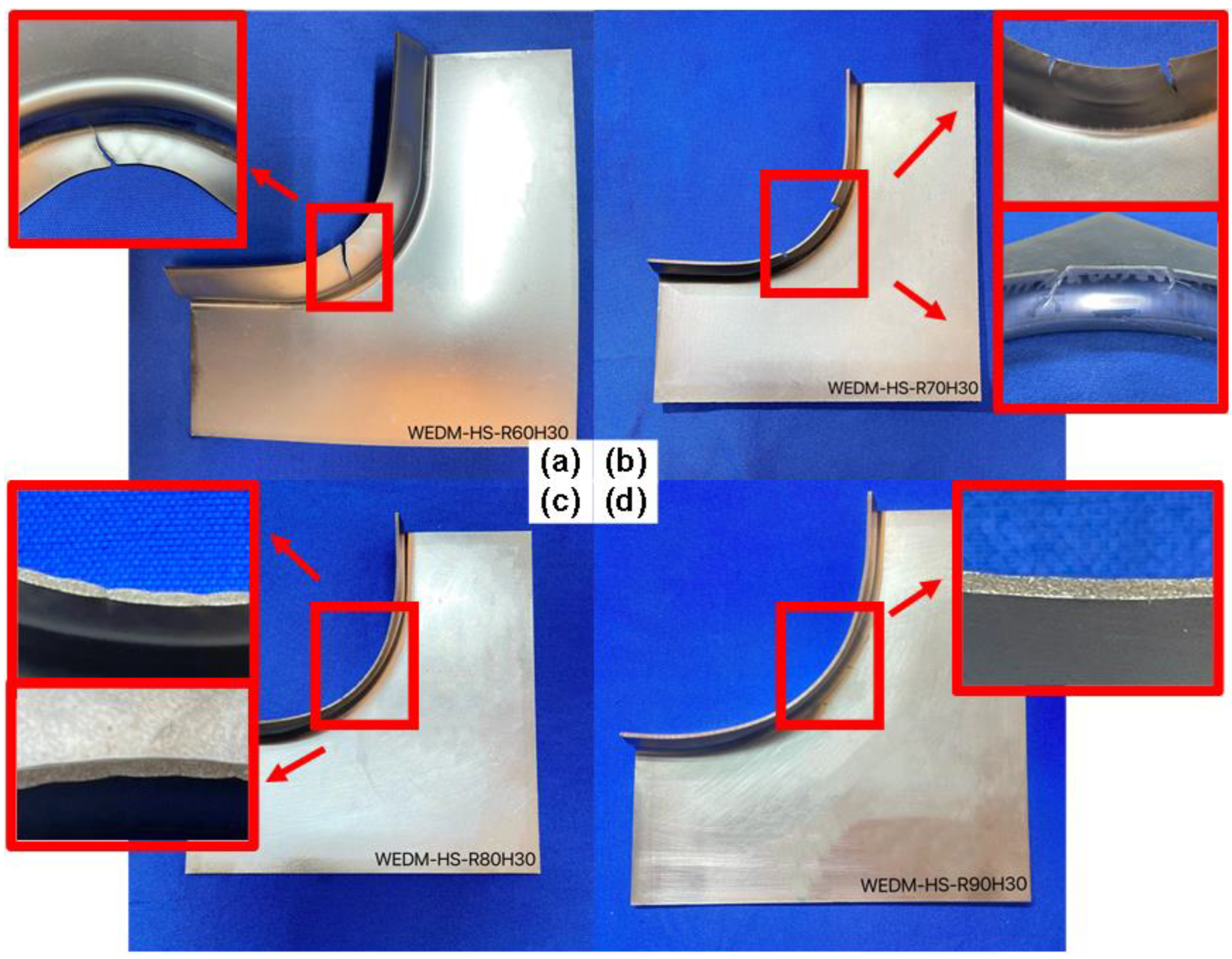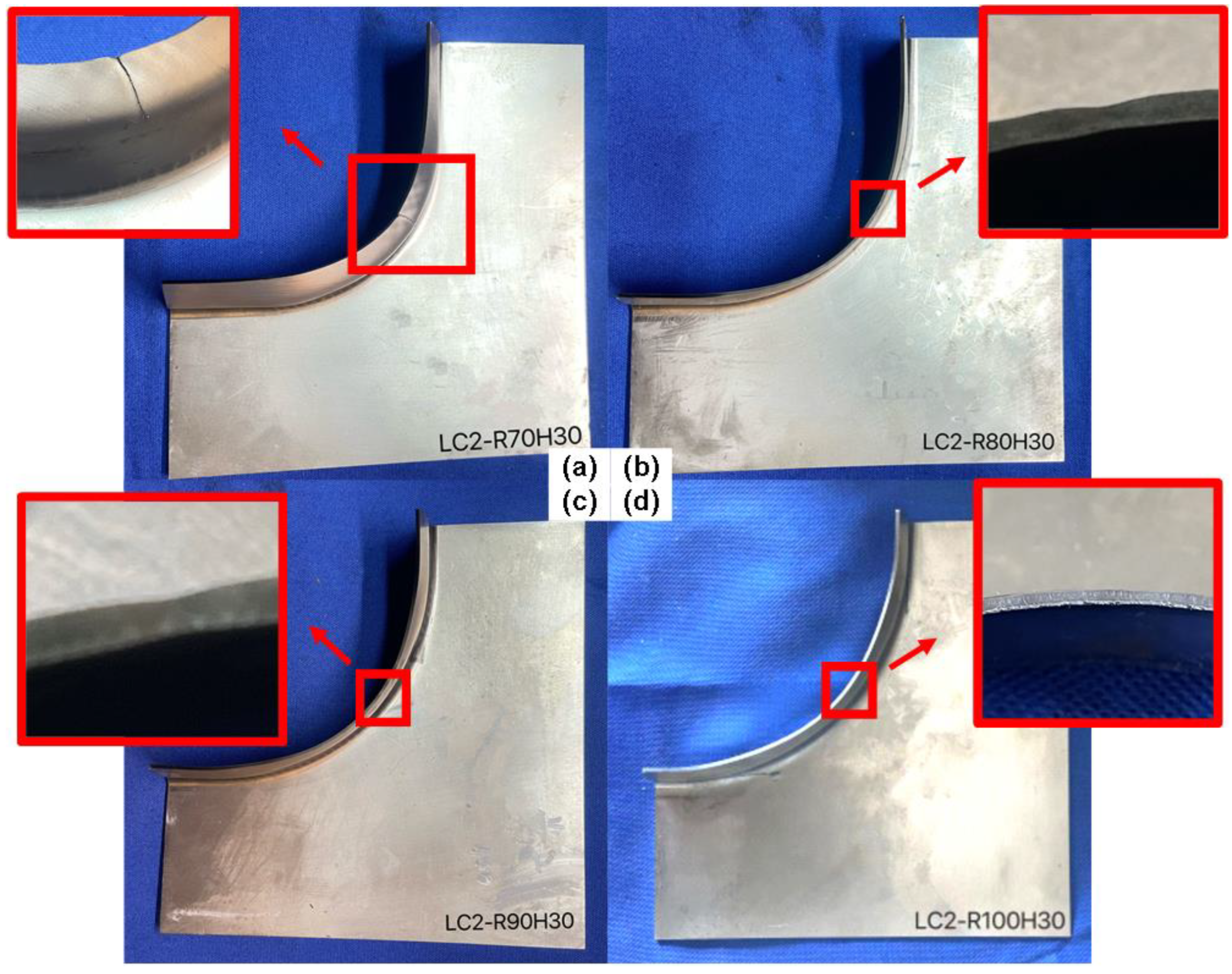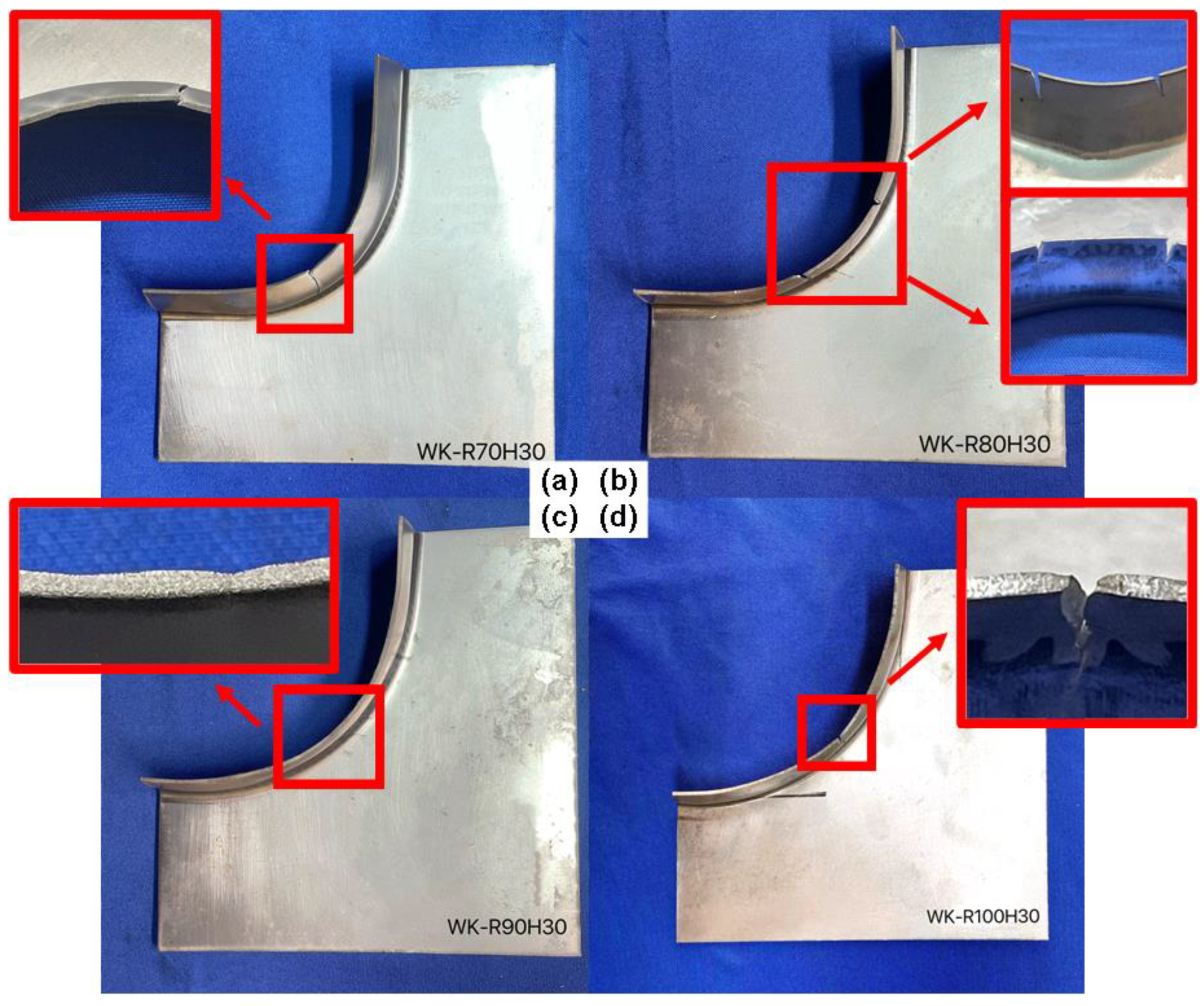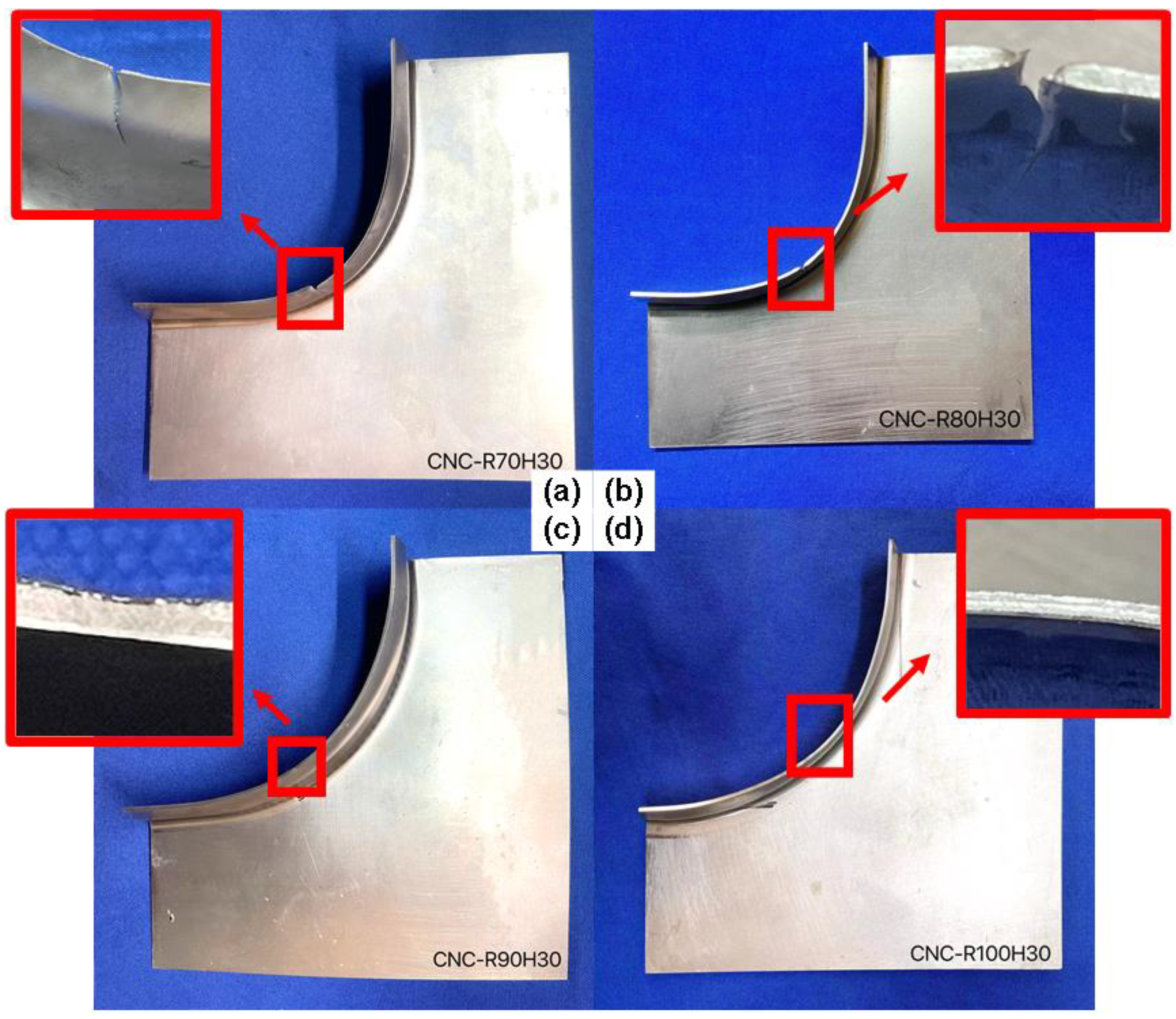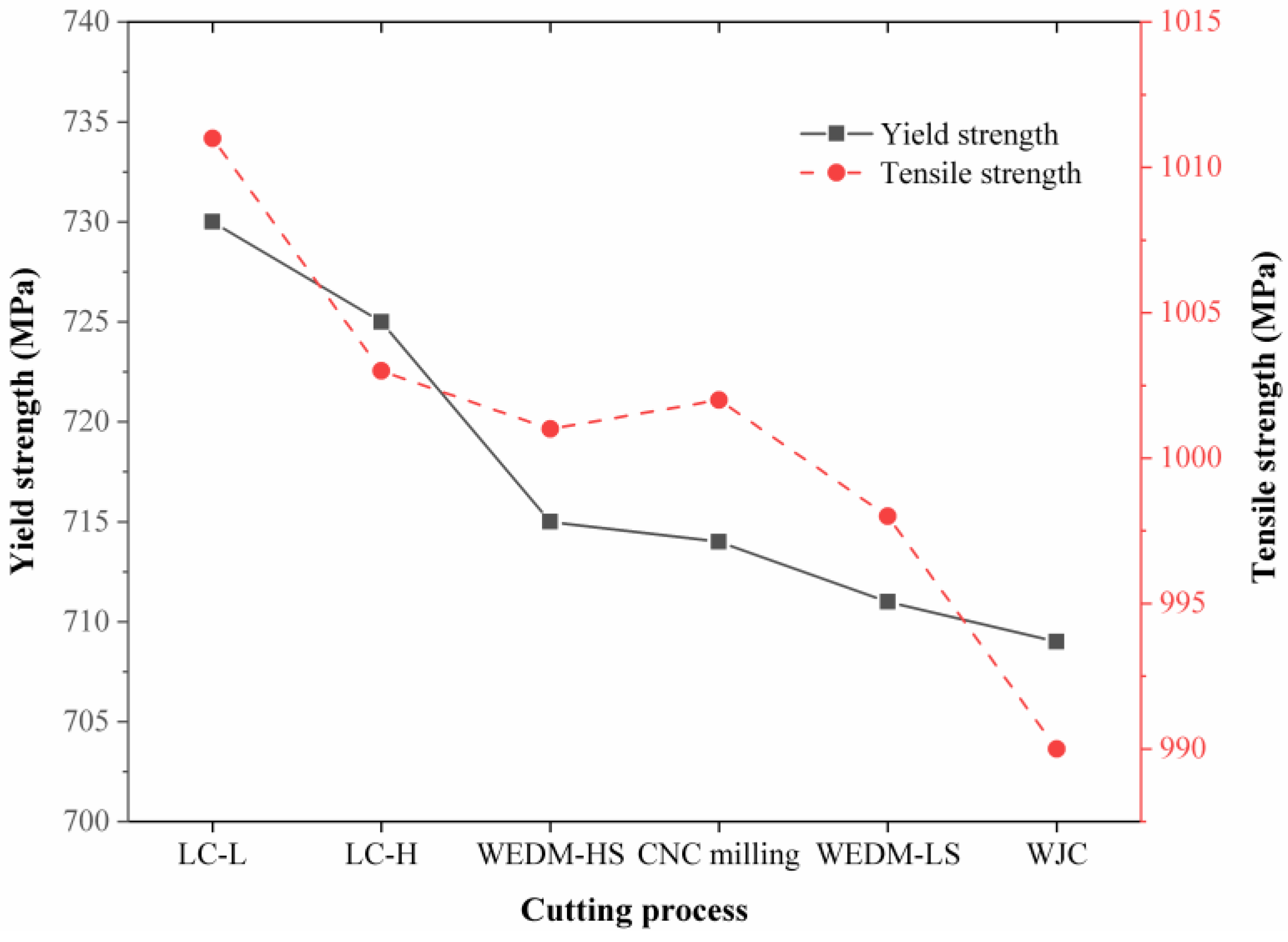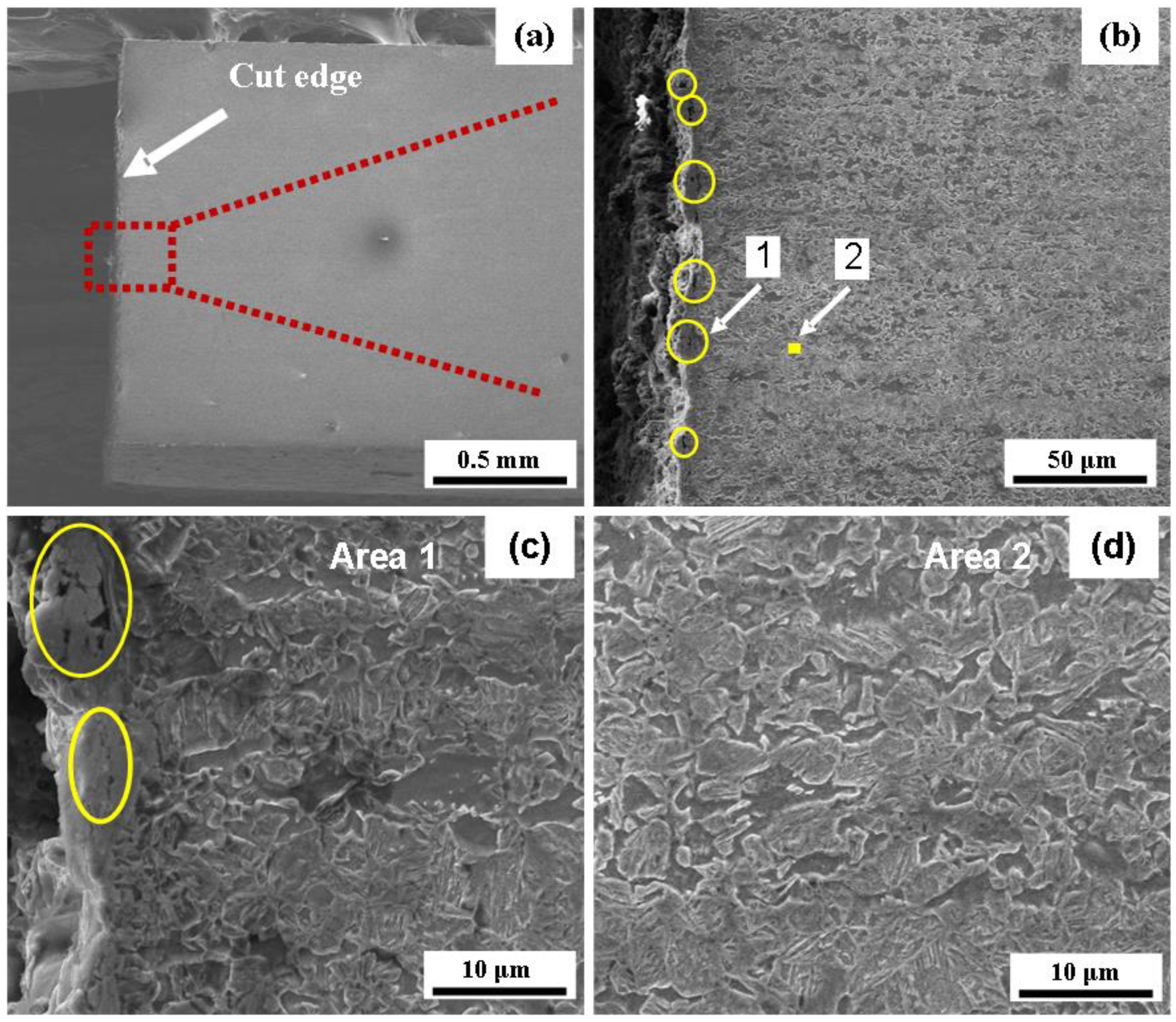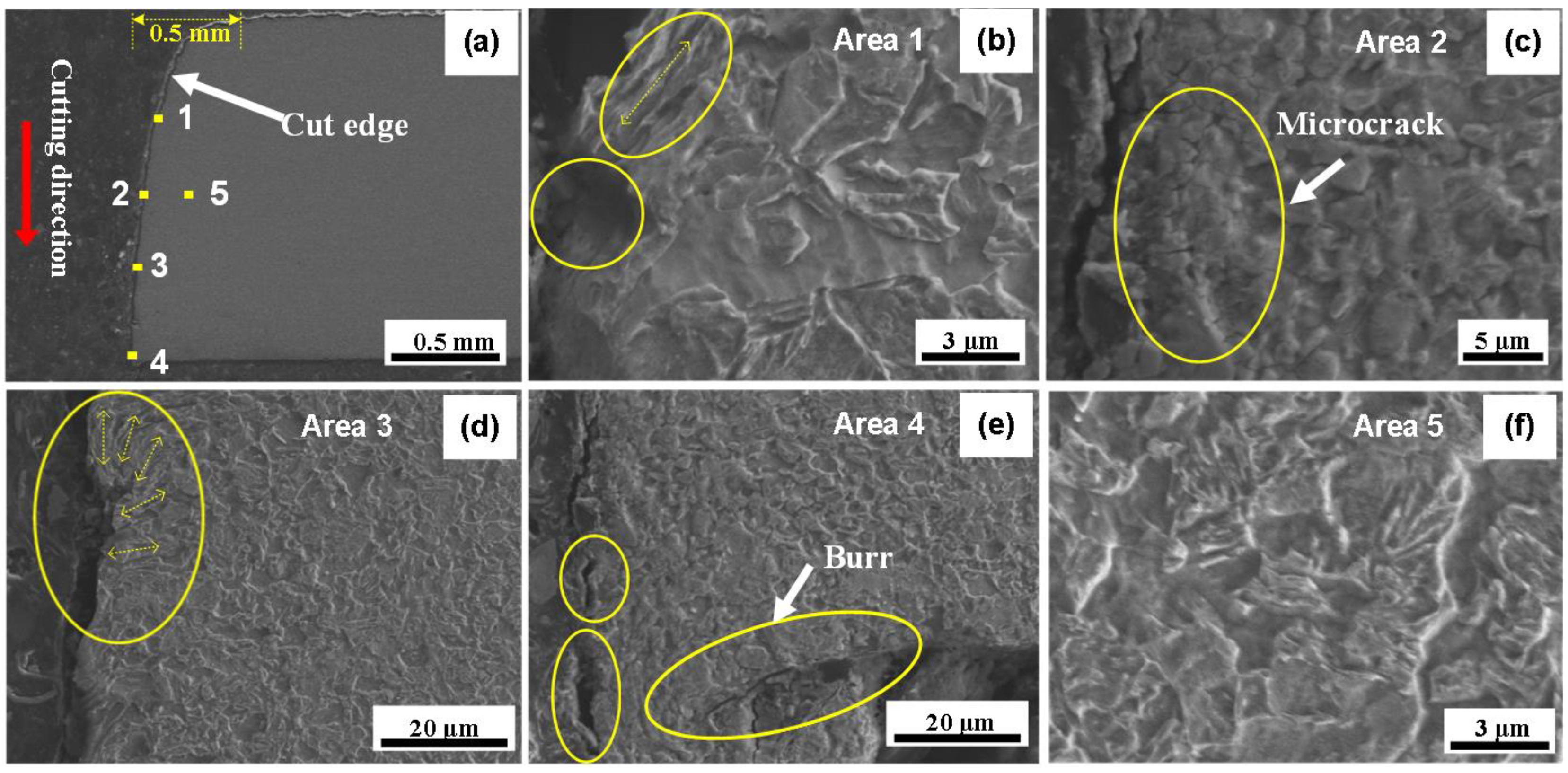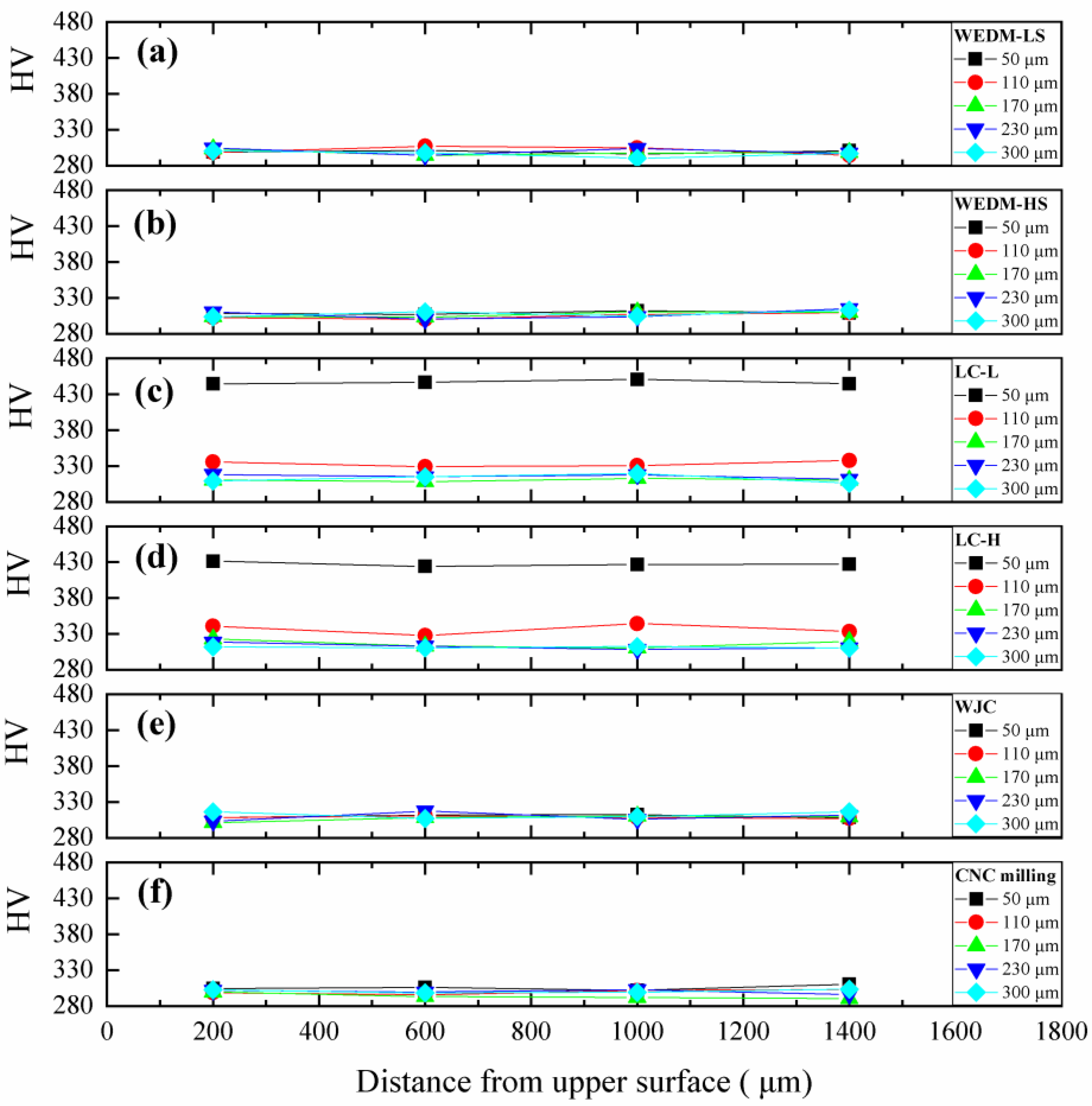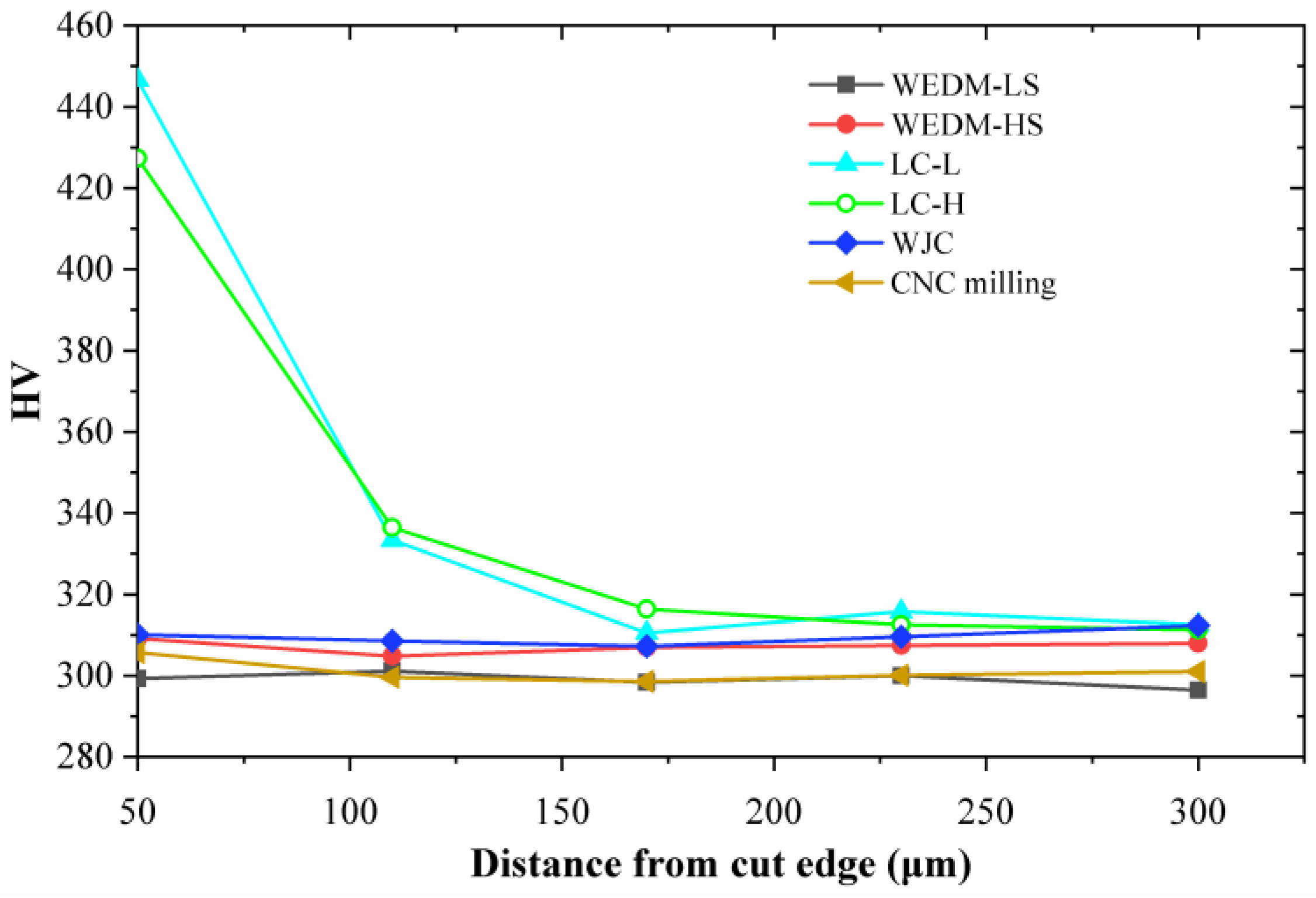With the increasing demand for lightweight parts in the automobile industry, ultra-high strength steel (UHSS, abbreviations are summarized in Abbreviation. The same below) is widely used in automobile structural parts; however, despite its good performance, the plate also appears to crack in the actual stamping process, which seriously affects the wide application of UHSS. Studies have shown that the main cause of sheet-edge cracking is the pre-damage defects left over from the cutting process [
1,
2]. However, UHSS plates usually show an obvious sensitivity to edge cracks; thus, in order to solve the problem of material cracking, researchers have studied the plates cracking from multiple sides. Khalilabad et al. [
3,
4] used a novel in-plane bending test to characterize the edge ductility of dual-phase steels and investigate the influence of material orientation, cutting parameters, and the global strain gradient on edge-fracture strain of DP800. Based on the modified Mohr–Coulomb fracture surface, Sandin et al. [
5] developed a numerical model for the shearing and cutting process of advanced high-strength steel blanks, which could predict the edge morphology in the shear-affected zone (SAZ). Basak et al. [
6] used the Hosford–Coulomb (HC) fracture model to predict the fracture initiation, and a hybrid experimental–numerical technique was adopted to calibrate the HC parameters. Based on this model, the influences of shear angle, shear gap, and punch radius on the shear edge characteristics of a DP980 sheet were investigated. Ben et al. [
7,
8] developed a variational formulation for predicting structure behavior and accounting for damage mechanics in metallic materials and verified the accuracy of these models in predicting ductile damage in forming and cutting processes. Feistle et al. [
9] used the edge-fracture-tensile test to identify the residual formability of the un-deformed and pre-formed specimens, confirming that the type and amount of pre-forming had different effects on the sensitivity of material edge cracks. During the cutting process, the residual damage at the cut edges would reduce the formability of the material and make it prone to edge cracking [
10].
Regarding dual-phase steel, it is more sensitive to edge properties, and blanking may lead to premature crack formation at the edge. Therefore, the academic community began to explore the use of alternative cutting processes, such as laser cutting, water-jet cutting, wire electrical discharge machining (WEDM), and CNC milling, besides mechanical shearing. Qian et al. [
11] studied hole-expansion tests under mechanical shearing and low-speed WEDM and proved that the damage caused by low-speed WEDM to the hole edge could be negligible. Tahir et al. [
12] studied the effects of different process parameters including laser power, cutting speed, auxiliary gas type, and auxiliary gas pressure on the cutting performance of UHSS in laser cutting. Thomas [
13,
14] studied laser edging of DP600 and found that the right balance between microstructure and optimal surface properties could be achieved by adjusting the combination of laser power and cutting speed. Zhou et al. [
15] conducted tensile tests on the cut edge of a QP980 sheet and proved that the tensile properties of the oblique edge blanking could be similar to those edges manufactured by WEDM or laser cutting. Goshert et al. [
16] showed through the tensile test results of QP980 and DP600 that the properties of the samples processed by WEDM and milling were similar, while the yield and tensile strengths of the samples cut by laser were higher. Water-jet cutting is another popular cutting process. Supriya et al. [
17] studied the influence of an abrasive water-jet machining (AWJM) process on material processing by changing the transverse velocity, abrasive mass flow rate, water-jet pressure, material thickness, etc. However, the forming effect of water-jet cutting was not clearly stated, and the reason for the difference was still unclear. Miraoui et al. [
18] proposed that an increase in laser-cutting speed and a reduction in laser power and beam diameter could reduce the depths of the melt zone and heat-affected zone (HAZ). Izmailov et al. [
19] proved that a gas laser-cutting process provided an optimal combination of microgeometry and mechanical properties of the cut surface, which made it possible to reduce or eliminate subsequent processing. Li et al. [
20] found that laser cutting also had an effect on the magnetic properties of the edge, which was manifested as a decrease in the relative magnetic permeability of the overall sample. Krajewski et al. [
21] observed the cut edge after laser cutting with confocal microscopy and confirmed that the laser cutting speed had a significant impact on the cut-edge quality. Chang et al. [
22] analyzed the effects of mechanical shearing, laser cutting, and WEDM on the straight-edge cutting performance of medium-Mn steel. The samples treated by the three processes showed different microstructures, and the WEDM samples showed the best tensile properties.
Moreover, flanging, as a subsequent step of cutting, can be used to process three-dimensional parts with more complex shapes, with good stiffness and reasonable spatial shape. At present, there are also many studies aimed at the improvement of the tensile flanging property of materials. Udhayakumar et al. [
23] investigated the effects of different process conditions and different microstructure and tensile properties on the hole-expanding characteristics, confirming the importance of the hole-expanding ratio (HER) in the selection of AHSS grade in the manufacture of complex parts. Syafiq et al. [
24] demonstrated that hot stamping of the material before flanging prevented the occurrence of springback and cracks, transforming the microstructure of the sheet into martensite, thereby increasing its hardness and strength. Wang et al. [
25] designed a new punch with notches that could accomplish multiple flanging steps in a single stroke, improving the tensile flanging capacity of AHSSs. Li et al. [
26] studied the effect of annealing process on the flanging formability of C-Mn series 590 MPa galvanized dual-phase steel. Habibi et al. [
27] studied the influence of SAZ on the prediction of edge cracks and HER. Compared with WEDM, mechanical shearing introduced greater damage and a lower HER. Balisetty et al. [
28] studied the influence of four different hole preparation techniques, including electrical discharge machining, drilling, drilling and reaming, and punching on the hole-expansion ratios. The above studies established a good foundation for research of the cutting and flanging process. Currently, there is still a lack of research for DP980 steel focused on systematically evaluating the quality of the cut edge, understanding the effect of the cutting process on the subsequent flanging process, and improving the formability of flanging after cutting.
Therefore, this paper is focused on the flanging process of the DP980 steel plate. A set of flanging tools is designed and manufactured to perform the flanging deformation after cutting. Different cutting processes such as WEDM, laser cutting, water-jet cutting, and CNC milling are investigated. The cracks, microstructure, and micro-hardness of the cut edge are compared to explore the effect of the cutting process on the flanging formability of the tested material. This research is helpful to understand the microstructural evolution mechanism of the cut edge and provide practical support for the selection of the optimal cutting–flanging process.
